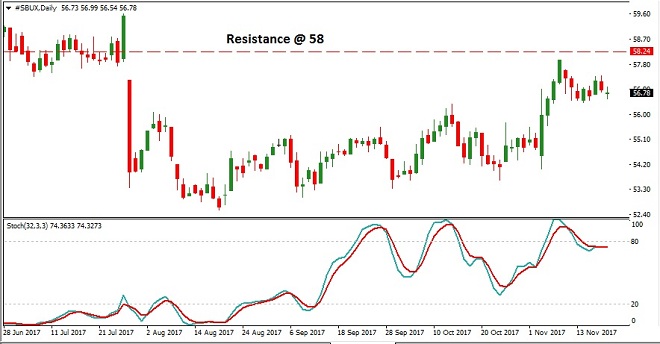 Premium coffee restaurant chain Starbucks Corporation (NASDAQ: SBUX) reported a mixed fiscal 2017 fourth-quarter results. While the earnings met analysts’ estimates, the revenues did not. Starbucks also missed the crucial same store sales estimate of analysts. Thus, the stock got hammered to $52 levels. However, in the past few trading sessions, the stock has climbed back to pre-earnings level of $57. We anticipate the downtrend to resume due to reasons given below.
Premium coffee restaurant chain Starbucks Corporation (NASDAQ: SBUX) reported a mixed fiscal 2017 fourth-quarter results. While the earnings met analysts’ estimates, the revenues did not. Starbucks also missed the crucial same store sales estimate of analysts. Thus, the stock got hammered to $52 levels. However, in the past few trading sessions, the stock has climbed back to pre-earnings level of $57. We anticipate the downtrend to resume due to reasons given below.
For the quarter ended October 1, the company reported revenues of $5.698 billion, almost flat when compared with $5.711 billion posted in the quarter ended October 2, 2016.
The Seattle-based company recorded net earnings of $788.50 million, or $0.54 per share, in Q4 2017, a 1.6% decrease from $801 million, or $0.54 per share, in the similar period last year.
Starbucks Coffee
Complex menu and inflow of mobile orders were mainly responsible for the slowdown, according to Starbucks.
Excluding the sale of Singapore and Germany retail operations, restructuring and impairment charges, and Starbucks foundation donation, among others, the Q4 non-GAAP earnings increased 10% to 0.55 per share from 0.50 per share last year. On average, Thomson Reuters Consensus estimates called for earnings of $0.55 per share on revenues of $5.80 billion.
Global same-store sales increased 2%, mainly driven by a gain in the average amount spent by customers. However, the figures missed Street Account estimates of 3.3%.
Starbucks pointed out that it had to close 1,100 locations, when the hurricanes Harvey and Irma hit the US. Excluding the negative effect of hurricanes, the comparable-store sales were up 3%.
In the US, same-store sales increased 2%, but below analysts’ estimates of 5% growth. The comparable same-store sales grew 8% in China. However, it grew only by 2% in Asia, against the market’s expectation of 3.2%.
Starbucks reported a 11% increase to 13.3 million in its membership program. Mobile orders represented 10% of transactions in the store operated by the company in the US.
The company is facing severe headwinds due to a slowdown in foot traffic at the shopping malls and a change in dining habits of the US consumers. Due to this, the company made a downward revision of its long-term outlooks. Starbucks now expects a long-term annual earnings per share growth of 12%, instead of 15% to 20% anticipated earlier. The company is also aiming to achieve an annual global same-store sales
growth of between 3% and 5%, and annual consolidated net revenue growth in the high-single digits.
Furthermore, Starbucks is making changes to streamline its non-coffee business. In this regard, the company has entered into an agreement with Unilever to sell its Tazo tea brand for $384 million. Starbucks bought the brand for $8.1 million in 1991. The sale of Tazo brand, which generates revenue of about $112.5 million per year, is expected to complete in the fourth-quarter this year.
Starbucks also plans to sell Teavana tea and coffee drinks through grocery and convenience stores. It can be remembered that Starbucks had already closed down all the 379 Teavana shops. Much to the disappointment of the management, during the recent quarter, mobile orders increased only 9%, while mobile pay rose 30%. Thus, flat Q4 sales and downwardly revised same store sales outlook is expected to keep the
stock of Starbucks bearish.
The price chart indicates a major resistance for the stock at 58.20. Further, the stochastic oscillator is in the overbought region. Thus, we can expect a decline to begin soon.

We may use the analysis to mimic a short position in the stock through the purchase of a put option. In order to invest, the option should be valid for one week and the stock should be trading near $57 in the NASDAQ.
